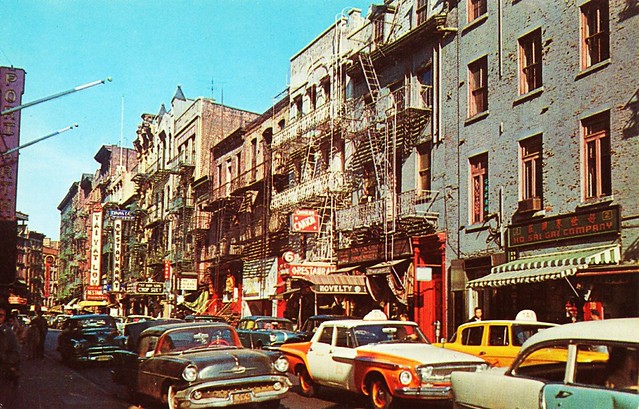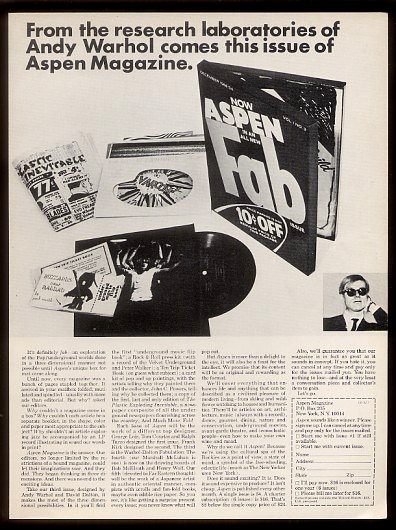
Kip Jones is Reader in Performative Social Science at Bournemouth University. As part of our Academic Inspiration series, in this essay Kip tells the story of the magazine ASPEN: a beautiful, playful, and intelligent publication running from 1965-71 that came in a box accompanied by poetry, Super 8 films, games, and LPs, and included such contributors as Susan Sontag and Andy Warhol.
The peculiar thing about the 1960s is that people think that the decade happened all at once, as though we woke up one morning to some sort of overnight transformation. We did not. Instead, we found ourselves, in transitory increments, participating in life differently, listening to new music, creating our own pastiche of alternative clothes to wear, and going to novel places or old haunts with new agendas.
-K. Jones, The One about Princess Margaret
In the 1960s everything was serendipitous; circumstances collided, and then morphed into new experiences by bringing some old ones along with them. It was the birth of the boutique, the discothèque, and several other hangouts and happenings given Francophile tags just for the sake of it. It was ‘Michelle, ma belle’ and the Beatles, but more; it was Motown and California dreaming.
The 1950s had spawned the first youth generation with money to spare—on records, clubs, cars and clothes. By the 1960s in the USA youth was an industry. We joked that we didn’t trust anyone over thirty… and we didn’t. Young people worked in fashion, advertising, beauty or music; that was where it was happening, and we were “where it’s at”.

Women’s Wear Daily, a New York rag-trade rag reinvented itself in the Sixties — by sheer will — into a kind of Bible of what was cool, what was groovy and what was next. A bunch of Mad Men types wrote for and/or edited the newspaper. Seventh Avenue and the garment industry (along with Upper East Side matrons) followed it religiously. In the 1960s, WWD hired talented up-and-coming young illustrators and savvy reporters who cleverly embedded fashion seamlessly into youth culture and vice versa. The publication rose to prominence by focusing on the human side of fashion in tandem with a cult of celebrity around designers.
Phyllis Johnson, an editor at WWD and Advertising Age and part-time Aspen, Colorado resident, along with a few WWD colleagues, came up with the idea for a magazine in a box—a gathering of multimedia materials rather than a single block of print. ASPEN, “The first 3-Dimentional Magazine” and “an Assemblage” debuted in October 1965. At first it referenced the city of Aspen’s aspiration as a seat of high culture, but Issue 3, designed by Andy Warhol, and then subsequent issues, sent the format reeling in novel directions. (The entire run of ASPEN, including audio and video recordings, has been painstakingly uploaded at UbuWeb. The list of contributors over the magazine’s short lifetime [1965-71] is breath taking.)
As reported in the New York Times, “The quality of the writing in the thing [was] consistently high, and most of the issues [are] flat-out beautiful to look at – they’ve been deeply influential in the design world”. Presented in a box, the magazine contained anything from poetry to a Super 8 film, a game or phonograph recording, with the premise that, “When a new issue arrives you don’t just read it – you hear it, hang it, feel it, fly it, sniff it, taste it, fold it, wear it, shake it, even project it on your living room wall”.
“Each issue had its own editor and designer. Everyone from Andy Warhol and David Dalton (The Pop Art Issue), Angus and Hetty MacLise (The Psychedelic Issue), and Brian O’Doherty (The Conceptual Issue) took control of the magazine. A special British Issue was conceived, which arrived complete with an Ossie Clark sewing pattern for British Knickers, souvenirs selected by Peter Blake, Yoko Ono’s phonograph recording No Bed For Beatle, and The Lennon Diary, an insight into the future written by John Lennon in 1968”. –AnOther 11 Sept. 2012.
Roland Barthes pivotal essay, “The Death of The Author” was included in ASPEN no. 5+6, item 3. Barthes wrote the essay especially for the publication (the first ever translation of the essay into English). The very same issue contained Susan Sontag’s “The Aesthetics of Silence”. As I have tweeted elsewhere, “I love you Susan Sontag, you are my Louise Butler”. I was sold.

Flash forward to the beginning of the 21st Century and a bedsit in Leicester. I was struggling with early days of web design and HTML, hating PowerPoint for its static forced grid presentational limits, and wanting to do more about showing what good research is, rather than just telling about it in text. I was developing the concept of a Performative Social Science (PSS) or the use of tools from the arts to research and/or disseminate social science. By means of the World Wide Web, I was linking with other scholars from around the world with similar aspirations.
At the same time, I came upon ASPEN on the Internet. It appealed to me because of my quandary, or how to make web-based material more interactive, more inviting, more aesthetically pleasing than just screen after screen of text. I allowed ASPEN to influence me and began thinking more in terms of an assemblage or a “cabinet of curiosities” (a juxtapositioning of disparate objects) as a concept and way forward to embed this three-dimensional thinking into virtual outputs.
The time came to test these ideas when the editors of the on line qualitative journal, Forum: Qualitative Social Research, agreed to a Special Issue on Performative Social Science. I enlisted co-editors from around the planet to help me with this. The FQS Special Issue on Performative Social Science provided a wide range of examples and manifestations of PSS, with contributions from various disciplines/subject areas, and realized through a wide variety of approaches to research practice. The Issue contained over 100 photographs and almost 50 illustrations, as well as 36 videos and two audio-recordings. Forty-two articles were produced by contributors from 13 countries and written in three languages. It was the largest Special Issue ever produced for the journal and continues to be heavily accessed and a useful resource.
Closer to ASPEN’s concept (and a few years later), a student came to me with a collection of DVD’s of audio and visual materials that she had produced as addenda to her PhD Thesis. She wasn’t certain how to submit these resources. Recalling ASPEN, I immediately suggested, “In a box!” We discussed the magazine’s format and its possibilities for her Thesis. In the end she not only produced a hand-crafted wooden box containing her potpourri, but also added additional items: scrolls of ‘one-liners’—rolled pieces of printed paper mimicking the contents fortune cookies, and entertainment for her examiners, including a hand puppet for them to have a conversation with. It was quite daring and experimental—just what arts-related research dissemination should be at its best! (She passed her Viva Voce, by the way.)
I return to ASPEN from time to time for inspiration. The chutzpah of it may simply be a result of the fact that it was a product of its unique time. The sheer force of the now-well-known contributors to the magazine, however, reminds me that influential thinking is frequently au courant and written by my contemporaries, not just penned by bearded old bards in berets.
The 1960s definitely was an ‘anything goes’ era where serendipity ruled. If ASPEN has ‘shaped me’ at all then that character takes the form of curiosity, fascination with cross-disciplinarity and, most of all, playfulness. ASPEN’s artfully concocted assemblages provide me with potential for the virtual world. The magazine’s issues personally stimulated me in the early days of development of Performative Social Science and continue to influence and help shape my use of arts-based tools in researching and/or disseminating social science.
————————————-
An exhibit of the entire run of ASPEN magazines was held at Whitechapel Gallery, London 11 September 2012 – 3 March 2013. Back issues of ASPEN are on sale at prohibitive prices, testimony to the magazine’s ongoing currency, but there are also complete runs in several art libraries.
————————————–
Kip Jones BA MSc PhD is Reader in Performative Social Science (PSS) at The Media School and the School of Health & Social Care at Bournemouth University. His efforts use tools from the Arts & Humanities in researching and/or disseminating Social Science subjects. He acted as Author and Executive Producer of the award-winning, research-based short film, Rufus Stone.





2 Comments